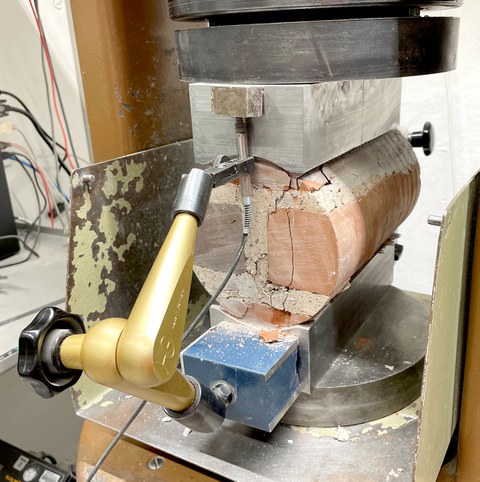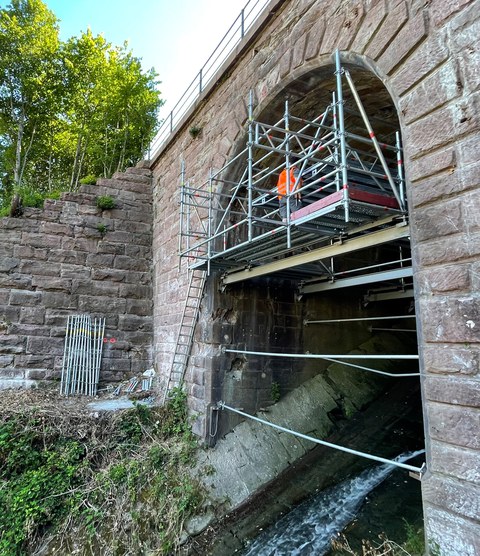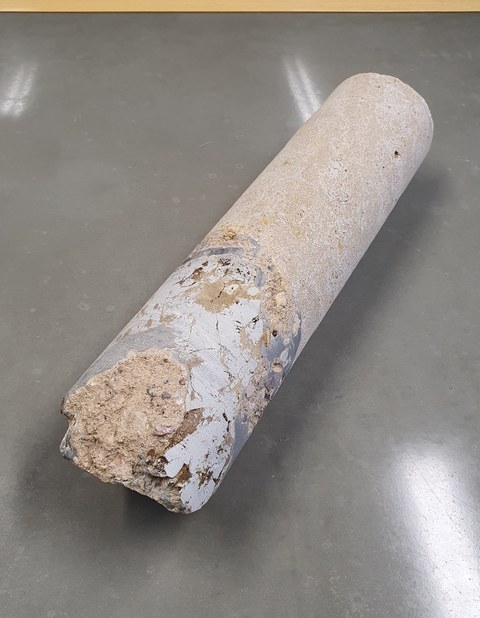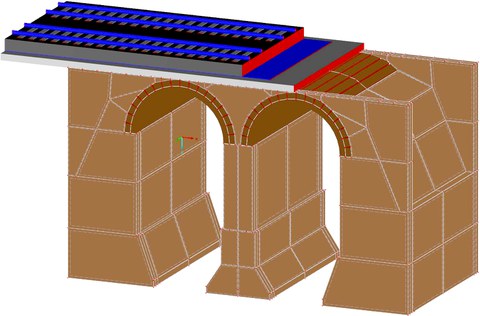Trough constructions on arch bridges
Table of contents
Project data
| Titel | Title Fahrbahnwannen auf Gewölbebrücken | Trough constructions on arch bridges Förderer | Funding DB InfraGO AG, Frankfurt am Main Zeitraum | Period Seit | since 01/2020 Leiter | Project manager Prof. Dr.-Ing. Steffen Marx Bearbeiter | Contributor Conrad Pelka, M.Sc. |
Report from year book 2023
Extension of the Deutsche Bahn regulations for arched bridges

Composite test specimen from a masonry vault in the test rig
After more than three years of research into arched bridges in the Deutsche Bahn network, an additional regulatory module for existing arched railroad bridges was handed over to the type approval authority in December 2023. The high durability, the associated CO2 savings potential, the cost reduction compared to a new construction and the architectural value were decisive criteria for transferring this construction method into a standardized regulation.
The handling of arched bridges relates to the actual recording of the existing structure and its condition. The focus is on the determination of building material parameters, structural analysis and possible repair measures. In a general first basic section, the scope of application is defined, the necessary regulations are listed and structural engineering terms are mentioned. In the second section, relevant geometric parameters that are important in the course of further use are defined. The third section deals with the procedure for the assessment of the existing building and the building diagnostics. The two-stage procedure of investigation planning with damage mapping and subsequent drill core extraction and sample preparation is concluded with the introduction of a protocol for recording the internal structure of the building. The fourth section deals with building material technology and structural analysis. In particular, reference is made to the masonry investigations for separate and connected test specimens, which, among other things, are dependent on the assessment levels of the static verification according to RIL 805.
In the final fifth section, repair and strengtheing measures are described. The construction methods, structural improvements to the existing structure and improvements to the backfill are discussed. Furthermore, roadway slab constructions are presented as a possible partial renewal concept on vault bridges with and without joint formation as well as the associated sealing measures. This ensures that an appropriate renovation concept for preservation and continued use can be derived from the large number of damage patterns.
Report from year book 2022
Retrofitting of railroad arched bridges

Tälesbach railroad arched bridge near Stuttgart
In some cases, railroad arch bridges in the existing network of Deutsche Bahn have a service life of more than 150 years. In order to ensure the operational safety also for future requirements, for example with regard to load increase and traffic density, a targeted retrofitting concept must be derived from the structural diagnostics and the damage pattern of the respective railroad bridge. The basis for this is usually a detailed damage mapping, e.g. on the vault arch and on rising components like the abutment area or the wing walls and the end walls, as well as knowledge of the microstructure, in order to be able to select a chemically and statically compatible building product to match the historic existing building materials.
The effect with the greatest damage potential is moisture. This can act on the structure as pressing or non-pressing water on the vault ridges and abutment areas. The pressing moisture is to be considered as horizontal and vertical load and acts with the backfill as a horizontal drifting force against the inside of the end wall, which often leads to longitudinal cracking in this area. Exposure to moisture and the lack of a transverse support structure lead to ever-increasing damage. The historic structure can be stabilized in the vault area by means of a general renovation, e.g. with a transverse bracing. Furthermore, cavities and defects can be closed by deep grouting or replacement by masonry areas. In order to keep out penetrating moisture, the vault ridge is to be exposed, the backfill isto be replaced by shear-resistant products in order to form the roadway slab on this subgrade. At the end of this slab, drainage points are to be defined to remove the surface and seepage moisture via the filter stone system.
With an appropriate black seal and a protective concrete level on the carriageway slab as well as caps placed on top, the arch bridge is simultaneously equipped with a new protective and safety space. With this comprehensive rehabilitation concept, an arch bridge can be operated again in the Deutsche Bahn network for more than 50 years.
Report from year book 2021
Diagnostics on arched bridges

Extracted drill core of an arch bridge
Arched bridges where moisture damage occurs, longitudinal cracks have formed in the vault soffit, or grout even falls onto the road below are usually scheduled for complete demolition and replacement with new construction. These signs can be registered and are not a reason for dismantling without replacement. Over the next 10 years, the oldest vault structures in the history of Deutsche Bahn, with service lives of over 150 years, are due for refurbishment., For this reason, two-stage structural diagnostics will be an increasingly important aspect in the context of a possible partial renewal.
Two-stage structural diagnostics means that in the first stage the structure is prepared for future investigations on the basis of historic documents. A visual assessment is carried out during an on-site visit. In this process, are for instance sampling points for drill cores determined on the basis of the damage pattern in areas of the full stone cross-section and with bearing and butt joints with different drill core diameters. For this purpose, damage mapping shall be prepared. It is recommended that the responsible monument authority is involved in the initial assessment so that their requirements are already communicated at this time. Corresponding contact forms have already been created with the working aid for historic railroad bridges.
In the second stage, samples are taken and evaluated. Here, not only the determination of building material parameters such as moisture content, compressive strength, splitting tensile strength and modulus of elasticity separately for the stone and the binders, but also the stone-mortar bond play an important role. The external and internal microstructure of the main bearing elements and the backfill areas should be recorded. The extracted cores are laid out in transport-safe drilling boxes, documented, digitized and handed over to the laboratory for evaluation. They can also provide direct information on retrofitting measures that have already been carried out, e.g. cavity injections.
Such a two-stage diagnosis can contribute to a successful recalculation and to the preservation of the existing vault in the context of the partial renewal by providing statistically secured building material parameters.
Report from year book 2020
Trough constructions on arched bridges

3D visualization of the basic superstructure of an arch bridge rehabilitated by means of a roadway trough
The arched bridges of the railroad are both important infrastructure objects and also formative cultural assets. Many of these bridges are in poor condition because of their age and DB AG plans to replace these bridges in the coming years. As an alternative to demolition and new construction, the retrofitting of the existing bridges with a roadway trough is to be further developed as part of a research project. The basic technology for this has been known for many years, but a wide variety of different solutions currently exist. Within the realized projects the occurred errors have neither been analyzed nor eliminated.
A standardized renovation guideline is to be launched. Significant defects in the form of leaking joints or seals and the aging of building materials are a frequent cause of a reduction in load-bearing capacity and restrictions in serviceability. Effective structural engineering concepts are to be developed, which are to be applied taking into account aspects of monument preservation. The results of the research project are to be incorporated into a module for RIL 804 and thus implemented directly in practice.
In the project, arch bridges with or without trough constructions are recorded as completely and systematically as possible in cooperation with DB Netz AG. The above-mentioned supplementary module will also include information on the considerations to be carried out in advance, such as damage assessment, subsoil excavations and building material investigations, etc.
The CO2 balance, the protection of historical monuments as well as the constantly updating planning law are increasingly moving into the focus of our building design and emphatically demand the use of existing resources or the preservation of old buildings or parts of buildings.
In addition to the aforementioned requirements, the conditions for the capitalization and financing of the construction measures on the balance sheet must be explicitly defined together with DB Netz AG in order to obtain as standardized an assessment basis as possible for the demolition and construction of old arch bridges. The objective of the expert project monitoring of selected arch bridge rehabilitation measures is to incorporate the knowledge gained from this into the above-mentioned module.
